| STI Forum | Shop | Sponsors | Advertise | Rules | FAQ | Members List | Calendar | ||
| Home | Register | Today's Posts | Go Premium | Create a Member Journal | Vendor Deals | Member Classifieds |
| |||||||
 |
| | Thread Tools |
 11-02-2007, 01:09 PM
11-02-2007, 01:09 PM
| #1 |
| Professional STI Racer
Car: 05 WRB STi Fav Mod: TiC AST's - 7/6K Location: Chesapeake, VA Posts: 631
IWSTI Addict since: Feb 2005 Trader Rating: (3) | EDIT:
Plots are updated to reflect some small changes, including a change in
the unsprung weight. I am NOT accounting for the spring rate of the
tire in any of these plots. A topic that has been talked about a lot lately in this suspension forum is the subject of selecting a spring and damper combo that is " 65% critically damped." All of this discussion has led to speculation on wether or not the scientific model actually works or not. I submit that until now, no one has acutally done an exhaustive comparison of both numerical modeling and actual real world seat-of-the-pants feel. I would like to start a discussion based on the numbers and graphs that I have provided below. It is not my intention to bash or praise any particular product. I would just like unbiased opnions from people who have expericence with some of the more popular (and not so popular) suspension packages out there so that we can "calibrate" the model to real world results. If anyone has dyno plots of dampers that I do no have below, please contact me via pm so that I can plot your data and add it to the discussion. For those of you unfamilliar with the 65% critically damped concept - here it is in a nutshell. If you consider one corner of your car to be a simple spring, mass and damper system any disturbance to the system will cause it to oscillate until the springs and dampers are done reacting. There is some spring choice for a given damper that will make the system critically damped. The critically damped case will dampen out the oscillation with no overshoot. If the system is underdamped, your car will bounce up and down as the bump is dampened out. Around 65-70% damped, the oscillation is over around the same time as the critically damped case, it just so happens to overshoot a little on the way there. For the over damped case, it actually takes longer than the critically damped case to dampen out the bump because the approach to the new steady state is so slow. Whenever possible I used the spring rates that come with the dampers. In the case of the GC's or Koni's I just used 400/300 to be consistent. I also assumed that if you were going to use either of those products, that you would probably upgrade your springs as well. The first two graphs are both for stock 2005 STi dampers. The reason that I provided both graphs is because I wanted to show that there can be a bit of variance between the same part on different dyno's. If I had to choose between Whiteline - a company that does real engineering and testing on their products - and the dyno of some random car magazine, I would choose Whiteline every time. The stock dampers actually look pretty good. Unfortunately, these graphs do not account for the bump stops. I'll add making a stock with bump stops adding to the overall spring rate graph to my list of things to do. This next graph shows the what a difference the dyno/operator can have: These are the first dampers that I tried to model because at the time there were a lot less options for the STi. BigSky had me analyze a specific set of spring rates for his WRX and I recommended that he use a softer setting than what he had been using. BigSky said his intial reaction was that they still felt pretty good. Maybe he can give us an update now that he has had a few months to drive around on them. EDIT: I have not had time to replot the WRX Konis. See below for BigSky's comments on going softer. I'm not really sure why the lines come out so wavy on some graphs. I think it has to do with the accuracy of pulling numbers off of the dyno plots. Overall, I would suspect from just looking at the graph that these ride very well as they are very close to being 65% critically damped in rebound and don't overshoot nearly as most dampers do at very low speeds. EDIT: Some of the graphs were coming out wavy because of modeling errors that have been corrected. Small bumps that produce low pistion speeds must feel very harsh since these are over 250% critically damped. If it wasn't for that, these wouldn't look so bad. 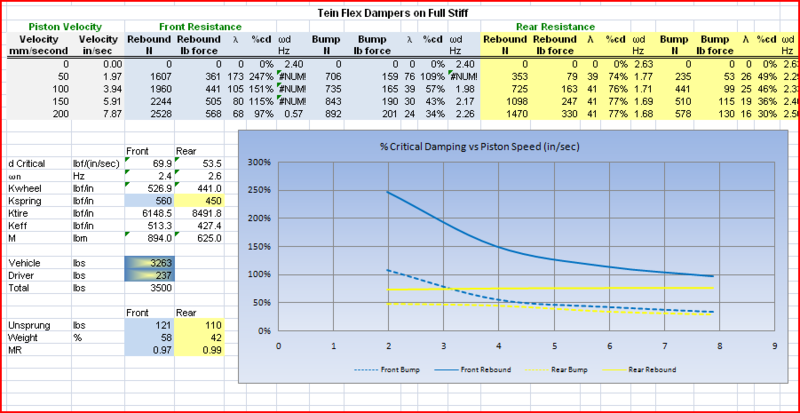 On full soft, these must feel like completely different dampers compared to full stiff. 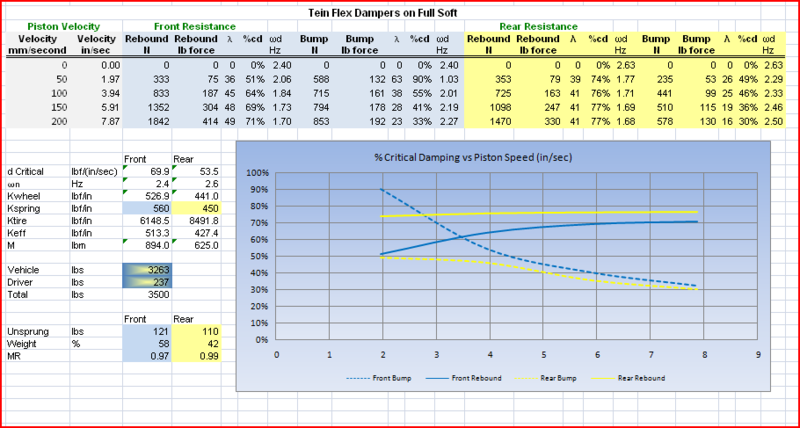 These are TiC's track settings. They were very suprised at how over damped they were considering their excellent performance. I can't wait to see their data for their upcoming project. 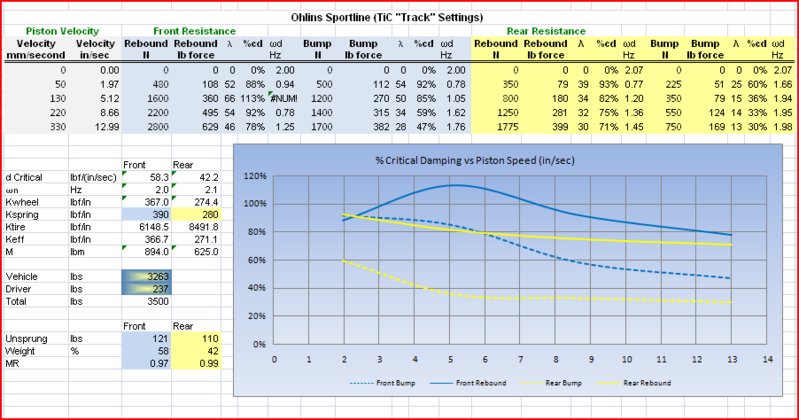 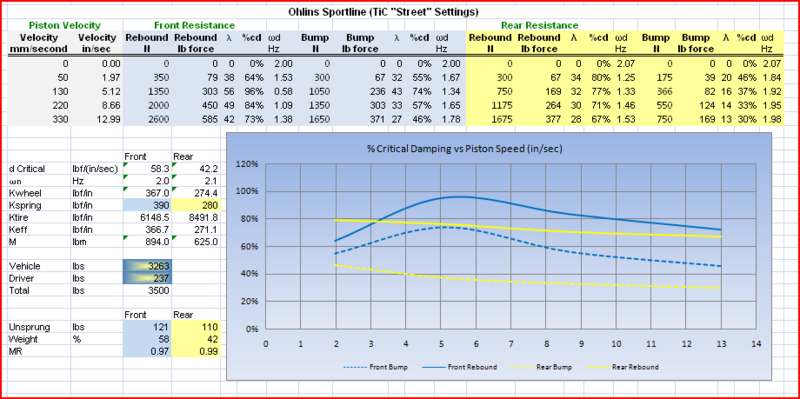 EDIT: Ground Control Koni's are very capable of running high spring rates, but would also be well suited to something around 400/300 f/r 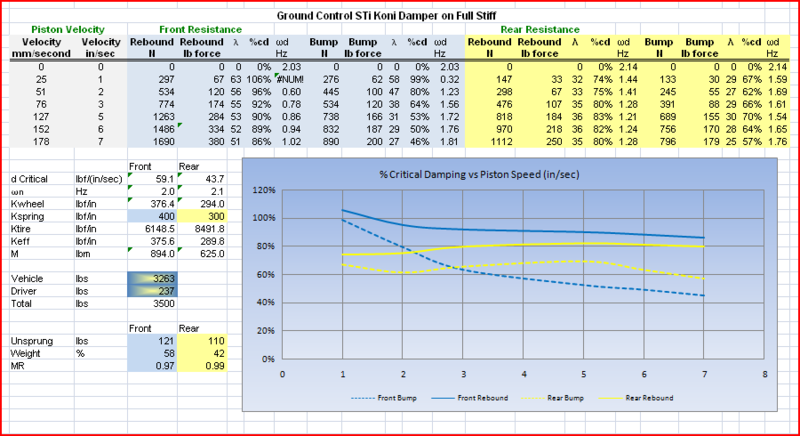 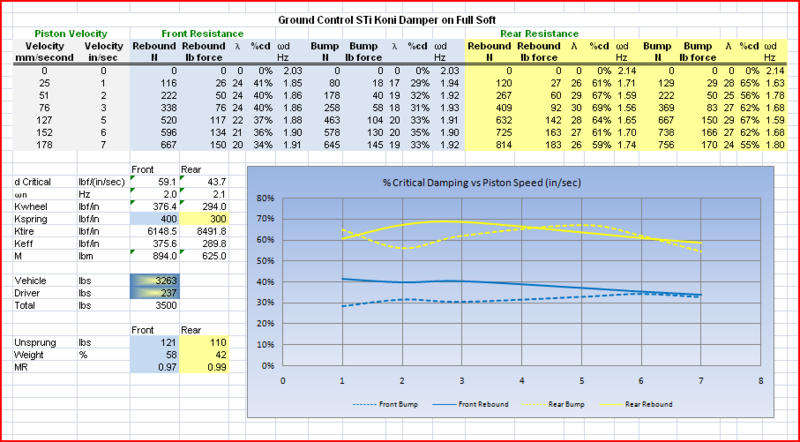 EDIT: New graphs for this post. The BC dyno plot was not written in English so I can only assume that these must be for the front dampers.  Here are TiC's custom speced AST Dampers 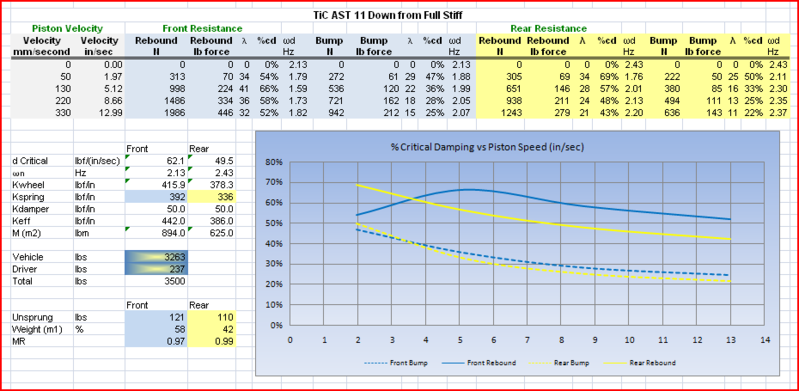 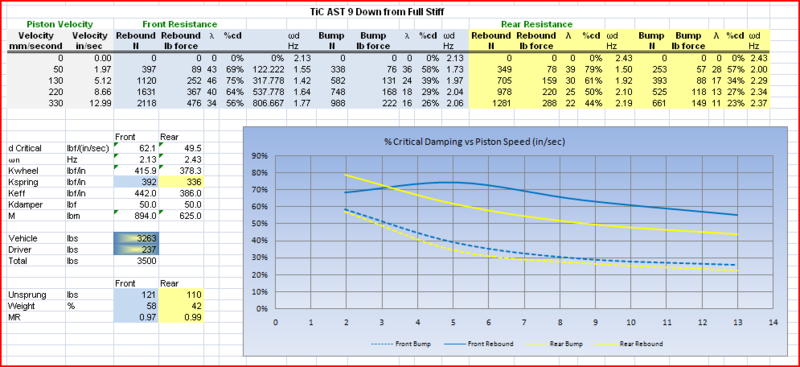 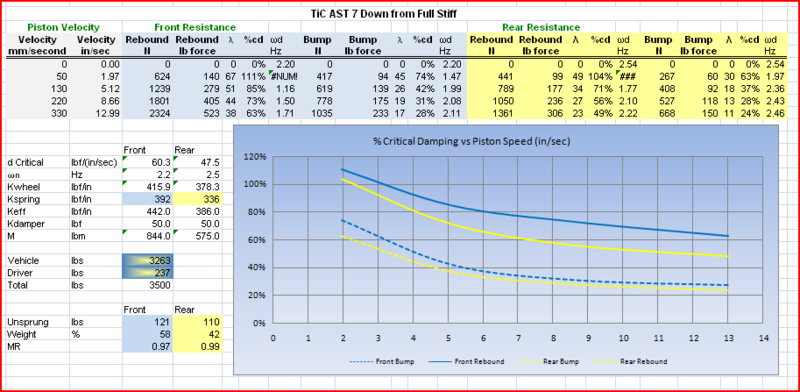 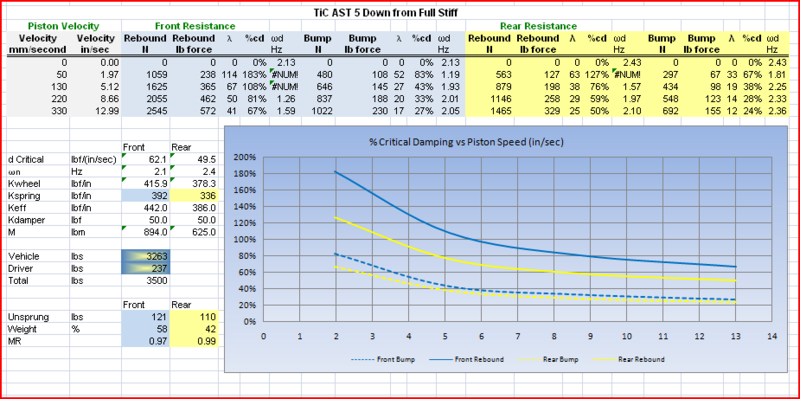 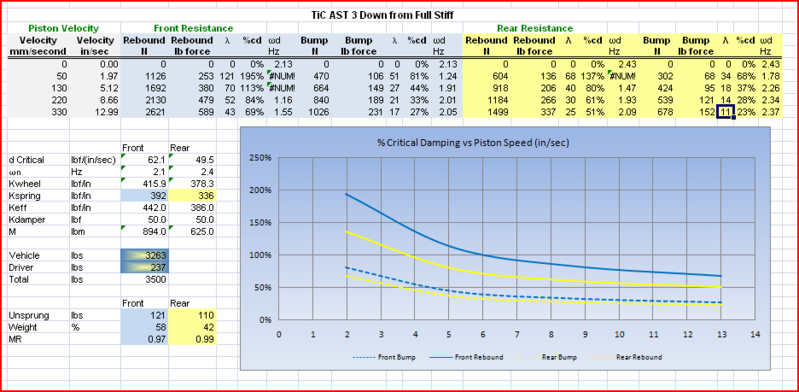 These last two graphs are of a generic "luxury" car. The chosen damper rates for this vehicle are almost linear, which shows that they definately weren't designed with performance in mind. They are very, very underdamped, which I would susupect decreases the quality of the ride because the vehicle will bounce up and down so much. I guess it is all in what you define as "comfortable." Now it's everyone else's turn to post up comments! This ad is not endorsed by this member. Please register or login to hide this ad. Last edited by 4banger; 03-09-2008 at 06:37 PM.. Reason: Updated RCE's spring rate to the actual rate - Thanks Myles |

|  |
 11-02-2007, 01:19 PM
11-02-2007, 01:19 PM
| #2 |
| Authorized Vendor | Mods,
can you sticky this please. This is going to quickly become THE
authoritative clearinghouse for Subaru damper information. |

|  |
 11-02-2007, 05:23 PM
11-02-2007, 05:23 PM
| #3 |
| Silver Member
Car: Aspen 2005 STi Fav Mod: TurnInConcepts Coilovers Location: Silver Spring, MD Posts: 2,028
IWSTI Addict since: Mar 2006 Trader Rating: (3) | Ah,
thanks for starting this thread! I just noticed my calculations don't
totally agree with yours. I haven't the time right now to figure out
the difference, but I'd like to. For anyone wanting to add more to this thread (or experiment yourself with shock dyno values), you can calculate charts similar to above using my suspension calculator. The thread for that is here (it'll look a little different, but the calculations are the same): http://www.iwsti.com/forums/suspensi...ator-more.html To see how these figures translate into chassis movement, I've found a great applet here (half way down the page): EN4: Dynamics and Vibrations Move the top-right slider around to set the "critically damped" value. Click "start" and watch how quickly the motion rests. At 100% critically damped, it takes too long to return to equilibrium. This means the car will get light and will "jack down" since, after a bump, the wheel cannot quickly return to the asphalt. At below 65%, it starts to overshoot equilibrium a little bit, but it's not until 40% that there's a lot of extra motion. I think that this makes very clear why the guideline of 65-70% critically damped is ideal for a performance car and why luxury cars typically go for even less. It gets more complicated when considering that modern shocks are digressive, meaning they are less critically damped at high speeds than low speeds. This means after a bump, a wheel will accelerate very quickly back to equilibrium but meet a lot of resistance as it slows down. Tein flexes are extremely overdamped until you get to the 4in/sec range where they soften considerably. Ohlins are are overdamped (but less so) through 8in/sec but remain somewhat overly damped beyond this point. The stock struts look to be the most comfortably valved of the bunch (relative to their spring rates). If not for their stiction issue, which does not show on the shock dynos, I suspect they would ride very well. This is a big flaw, however. Shock dynos measure resistance of a shock in motion; the stock STI struts have the problem of resisting the start of motion. That's why the stock ride feels a bit choppy. One can assume that twin-tube struts will have the least static friction (stiction), followed by monotubes, and inverted monotubes having the most. Whiteline, Koni, and TiC look decent. Of the bunch, TiC has the most low-speed valving with strong digression thereafter, and Whiteline has the least. The Whitelines therefor do not look very track-oriented but do look comfortable. The TiC's have gobs of this low-speed control at most settings and look very nice indeed. I hope this page helps people understand the extreme importance of what these graphs show. As Dennis Grant says, do not buy any shock, strut, or coilover from a vendor who will not provide you with a shock dyno. After seeing some of the above charts, I fully support this mentality. Again, echoing what Dennis Grant says, the vast majority of the market seems to be overdamped. This is bad for comfort and performance- a lose-lose! Last edited by stretch; 11-15-2007 at 05:20 AM.. |

|  |
 11-02-2007, 05:54 PM
11-02-2007, 05:54 PM
| #4 | |
| Professional STI Racer
Car: 05 WRB STi Fav Mod: TiC AST's - 7/6K Location: Chesapeake, VA Posts: 631
IWSTI Addict since: Feb 2005 Trader Rating: (3) | Quote:
I think there are two differences. I used your tire rate estimates and calculated a value for the spring rate of the tire. I then added it "in series" with the rate for the spring. The second difference is that in the previous version of my calculations, I was only concerned with very low speeds. When I did this, I was just using one points Force divided by piston speed. What you really want to use the slope of the dyno plot at the given point you are analyzing. The difference is negligable at low speeds. In fact, in the data that you gave me above for the "luxury" vehicle was calculated just using the F/piston speed because the whole graph is fairly linear. In all of the above graphs, I used the actual slopes. The second difference is most noticable when you see that all of my graphs start at (0,0) and then quickly shoot up. I use a pair of dividers to subdivide the Force axis into smaller increments and then pick the points off of the normal piston speed increments. | |

|  |
 11-02-2007, 07:13 PM
11-02-2007, 07:13 PM
| #5 |
| Grassroots STI Racer Car: 06 STI - SGM Fav Mod: HPDE Location: Long Island, NY Posts: 570
IWSTI Addict since: Dec 2004 Trader Rating: (1) | Good
job on the plotting thus far, but I hope you fellas plan on doing some
"testing" backed by datalogs. All this graphing and dynoing is nice and
gives a good impression of what one can expect, but there comes a time
to put the rubber to the road. I've usually kept my distance with these "types" of threads... math/theory/hypotheticals ...not my thing. But sometimes, among the pages of theory and the math-turbation, someone makes a good point...but it's never backed-up with "real-world" data. I like to "feel" a set-up and take times, log my g's , see what works and what doesn't...why is that never done? If that type of data can be logged and added to the thread, then you might have something here. Be good, TomK Last edited by ace996; 11-02-2007 at 07:38 PM.. |

|  |
 11-02-2007, 07:36 PM
11-02-2007, 07:36 PM
| #6 | |
| Authorized Vendor | Quote:
Now given this you are correct, we need to get real world feedback. Certainly we've seen lots of reviews of a number of setups all over this and other boards. The Ohlins sportlines are a good example. According to the math they are severely overdamped, but I think just about anyone who tried a number of different setups can quite easily say they feel pretty darn good. In fact, I'm hoping to be able to back that up with G data soon if Tony and I can get a few hours free. We'll set up both cars we have the same, slap in the data logger, and go drive the same route in the same fashion in both. This should give us a side by side comparison of the Ohlins, the ASTs (of which the data will be added to the list above in the near future) and perhaps we'll go borrow some locals cars for more data points provided we can get a match for some of the dampers listed above. | |

|  |
 11-02-2007, 08:01 PM
11-02-2007, 08:01 PM
| #7 | |
| Grassroots STI Racer Car: 06 STI - SGM Fav Mod: HPDE Location: Long Island, NY Posts: 570
IWSTI Addict since: Dec 2004 Trader Rating: (1) | Quote:
The Ohlins...I really considered those (went with the RCE T2s instead) and have heard nothing but goodthings about them. Overdamped?...put on some stiffer springs and re-run the numbers. Why are the springs used on the above plots so soft? Good luck wiht the testing, TomK | |

|  |
 11-03-2007, 03:40 AM
11-03-2007, 03:40 AM
| #8 | |
| Silver Member
Car: Aspen 2005 STi Fav Mod: TurnInConcepts Coilovers Location: Silver Spring, MD Posts: 2,028
IWSTI Addict since: Mar 2006 Trader Rating: (3) | I
see the differences. I don't agree with them, but I'll PM you about
that. (I wish I had caught this earlier so we could have this
discussion prior to the graphs being posted.) Quote:
That said, it does get complicated since dampers are not linear. This means how over or underdamped you are depends on the piston velocity (ie, the size of the bump you hit). In these cases, I think it is the average piston speed and damping force that matters. And, the average damping force will change depending on the size of the bump. Hitting a raised manhole might be 20in/second, but a wrinkle in the pavement might be 8in/second. I doubt a track car often sees much above 5in/second. I'd only consider a damper truly overdamped if it is above 65% critically damped through its entire range. Below that, you're right, I think I'd need more data to see how the slope affects things. | |

|  |
 11-03-2007, 03:48 AM
11-03-2007, 03:48 AM
| #9 |
| STI Guru
Car: 05 CGM STi Fav Mod: grip. Location: Southeastern PA Posts: 5,864
IWSTI Addict since: Aug 2006 Trader Rating: (7) | i really wish i knew what all that stuff meant. and how about some Ohlins FPS/RCE yellows, that seems to be a fairly popular street set up... and mine lol |

|  |
 11-03-2007, 04:28 AM
11-03-2007, 04:28 AM
| #10 |
| Junior STI Driver | Promising project but only when backed-up by real testing. When theory disagrees with reality then the theory is wrong. As an example the 'theory' as presented seems to indicate the Ohlins are horribly overdamped but I think you'll struggle to find anyone who says they are actually horrible. Lets not get too fixated on a 'golden' 65% number. This ad is not endorsed by this member. Please register or login to hide this ad. |

|  |
| |
| |
 |
| |
| New To Site? | Need Help? | More |